The Impact of Minimum Wage on Unemployment: An Economic Perspective
VerifiedAdded on 2022/08/27
|10
|2711
|30
Essay
AI Summary
This essay investigates the impact of minimum wage on unemployment, a key topic in economics. It begins by establishing the economic principles of labor markets, explaining how wages, supply, and demand interact. The essay then delves into the theoretical effects of minimum wage, using graphical representations to illustrate how it can lead to decreased labor demand and increased unemployment, depending on the wage elasticity of labor demand. Furthermore, the essay contrasts theoretical predictions with empirical evidence from the UK and Australia, where minimum wage policies have not always resulted in increased unemployment, attributing this to factors like employer adaptation and price adjustments. The essay also presents evidence from South Africa and other developing countries to show the varying effects of minimum wage in different contexts. The conclusion summarizes the theoretical arguments, empirical findings, and the importance of considering the elasticity of labor demand when evaluating the impact of minimum wage policies. It highlights that while general economic theory suggests a negative impact on employment, real-world outcomes can vary significantly.
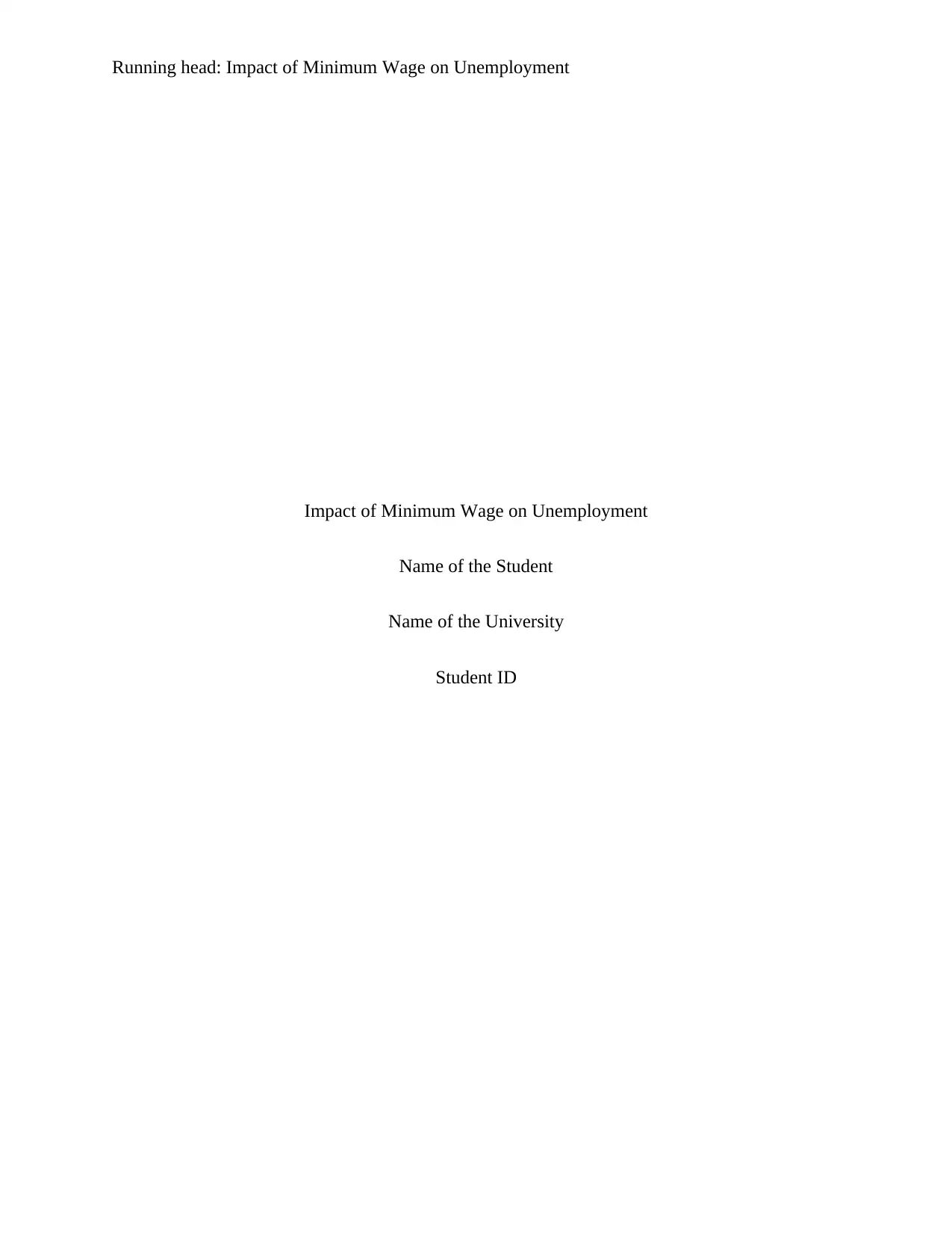
Running head: Impact of Minimum Wage on Unemployment
Impact of Minimum Wage on Unemployment
Name of the Student
Name of the University
Student ID
Impact of Minimum Wage on Unemployment
Name of the Student
Name of the University
Student ID
Paraphrase This Document
Need a fresh take? Get an instant paraphrase of this document with our AI Paraphraser
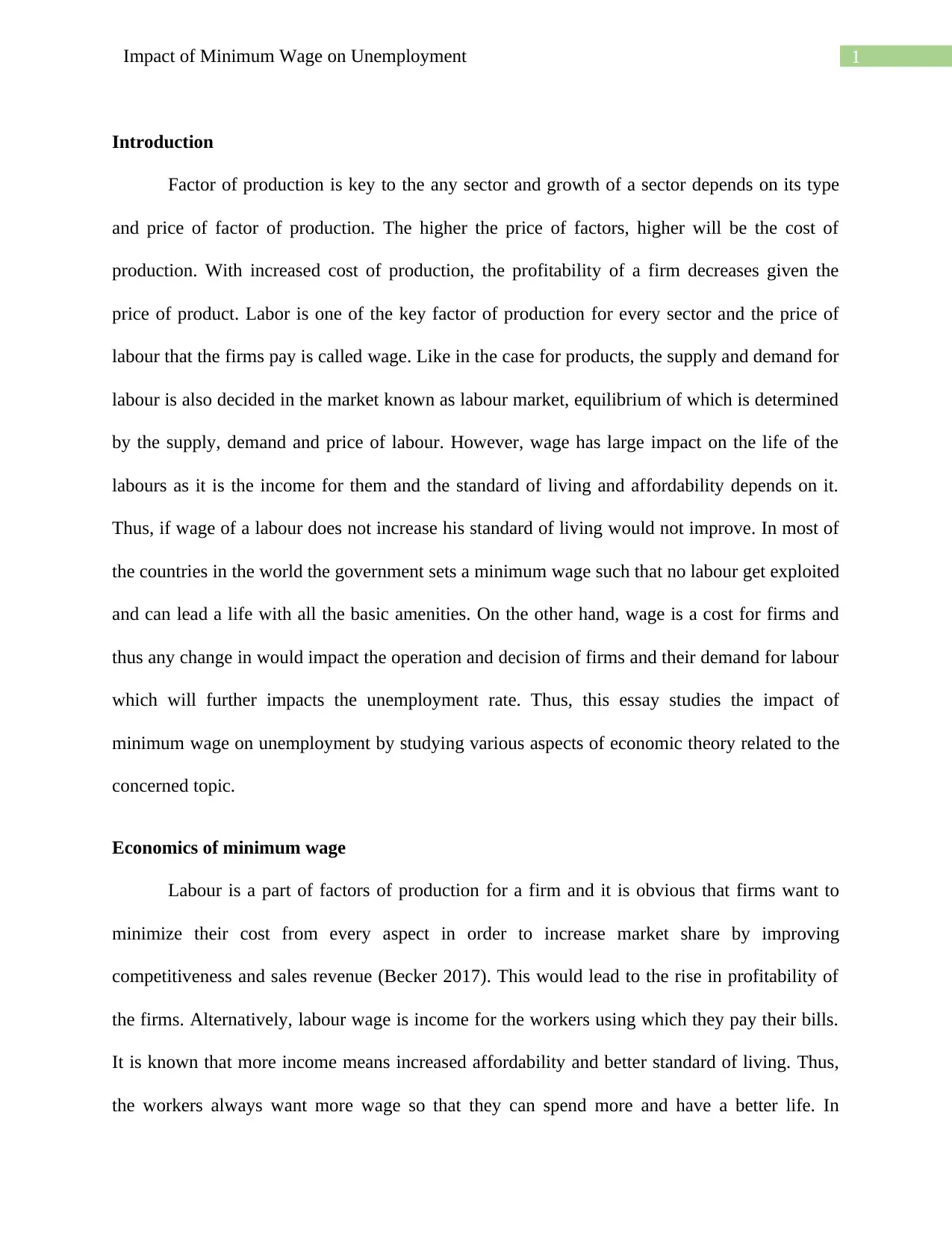
1Impact of Minimum Wage on Unemployment
Introduction
Factor of production is key to the any sector and growth of a sector depends on its type
and price of factor of production. The higher the price of factors, higher will be the cost of
production. With increased cost of production, the profitability of a firm decreases given the
price of product. Labor is one of the key factor of production for every sector and the price of
labour that the firms pay is called wage. Like in the case for products, the supply and demand for
labour is also decided in the market known as labour market, equilibrium of which is determined
by the supply, demand and price of labour. However, wage has large impact on the life of the
labours as it is the income for them and the standard of living and affordability depends on it.
Thus, if wage of a labour does not increase his standard of living would not improve. In most of
the countries in the world the government sets a minimum wage such that no labour get exploited
and can lead a life with all the basic amenities. On the other hand, wage is a cost for firms and
thus any change in would impact the operation and decision of firms and their demand for labour
which will further impacts the unemployment rate. Thus, this essay studies the impact of
minimum wage on unemployment by studying various aspects of economic theory related to the
concerned topic.
Economics of minimum wage
Labour is a part of factors of production for a firm and it is obvious that firms want to
minimize their cost from every aspect in order to increase market share by improving
competitiveness and sales revenue (Becker 2017). This would lead to the rise in profitability of
the firms. Alternatively, labour wage is income for the workers using which they pay their bills.
It is known that more income means increased affordability and better standard of living. Thus,
the workers always want more wage so that they can spend more and have a better life. In
Introduction
Factor of production is key to the any sector and growth of a sector depends on its type
and price of factor of production. The higher the price of factors, higher will be the cost of
production. With increased cost of production, the profitability of a firm decreases given the
price of product. Labor is one of the key factor of production for every sector and the price of
labour that the firms pay is called wage. Like in the case for products, the supply and demand for
labour is also decided in the market known as labour market, equilibrium of which is determined
by the supply, demand and price of labour. However, wage has large impact on the life of the
labours as it is the income for them and the standard of living and affordability depends on it.
Thus, if wage of a labour does not increase his standard of living would not improve. In most of
the countries in the world the government sets a minimum wage such that no labour get exploited
and can lead a life with all the basic amenities. On the other hand, wage is a cost for firms and
thus any change in would impact the operation and decision of firms and their demand for labour
which will further impacts the unemployment rate. Thus, this essay studies the impact of
minimum wage on unemployment by studying various aspects of economic theory related to the
concerned topic.
Economics of minimum wage
Labour is a part of factors of production for a firm and it is obvious that firms want to
minimize their cost from every aspect in order to increase market share by improving
competitiveness and sales revenue (Becker 2017). This would lead to the rise in profitability of
the firms. Alternatively, labour wage is income for the workers using which they pay their bills.
It is known that more income means increased affordability and better standard of living. Thus,
the workers always want more wage so that they can spend more and have a better life. In
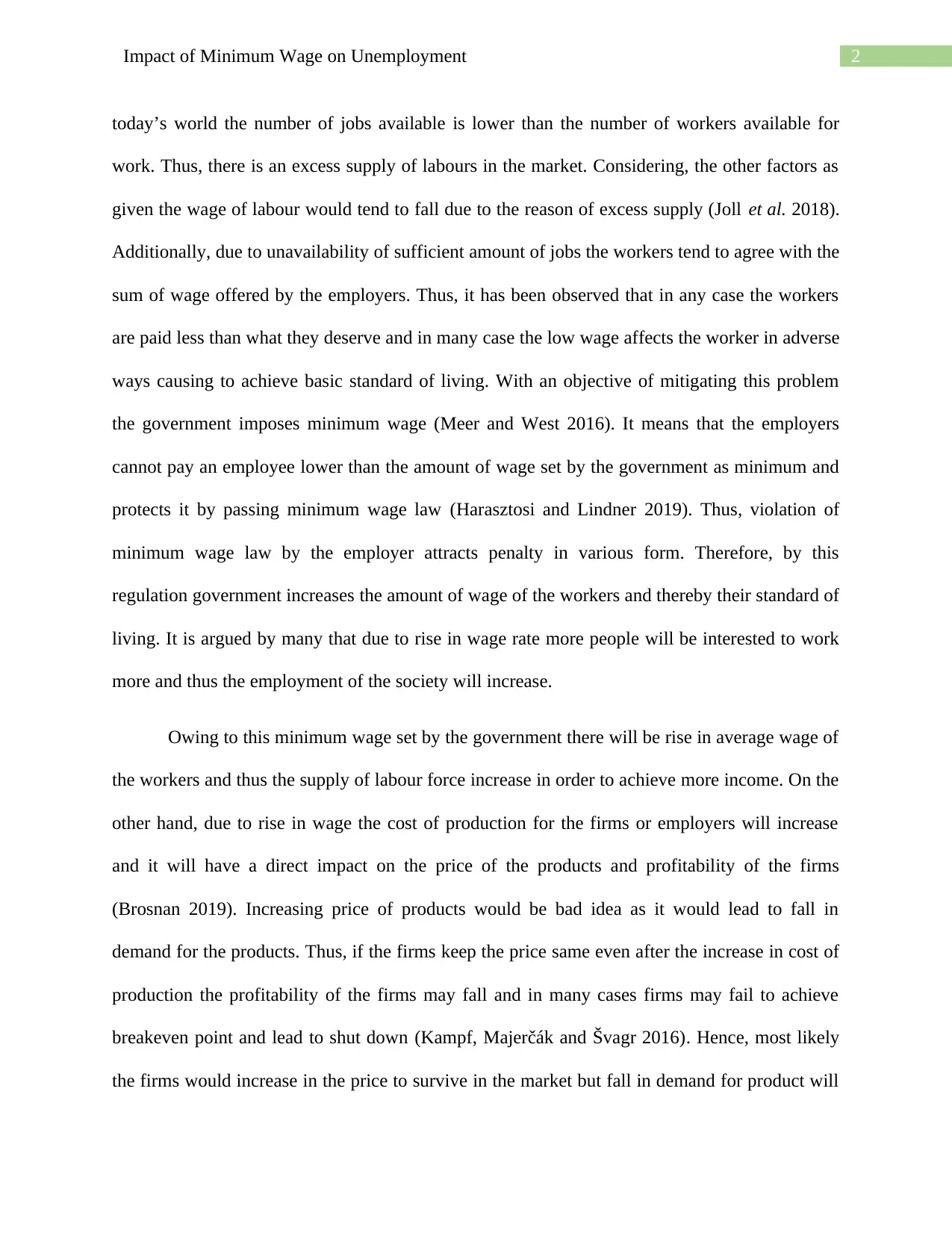
2Impact of Minimum Wage on Unemployment
today’s world the number of jobs available is lower than the number of workers available for
work. Thus, there is an excess supply of labours in the market. Considering, the other factors as
given the wage of labour would tend to fall due to the reason of excess supply (Joll et al. 2018).
Additionally, due to unavailability of sufficient amount of jobs the workers tend to agree with the
sum of wage offered by the employers. Thus, it has been observed that in any case the workers
are paid less than what they deserve and in many case the low wage affects the worker in adverse
ways causing to achieve basic standard of living. With an objective of mitigating this problem
the government imposes minimum wage (Meer and West 2016). It means that the employers
cannot pay an employee lower than the amount of wage set by the government as minimum and
protects it by passing minimum wage law (Harasztosi and Lindner 2019). Thus, violation of
minimum wage law by the employer attracts penalty in various form. Therefore, by this
regulation government increases the amount of wage of the workers and thereby their standard of
living. It is argued by many that due to rise in wage rate more people will be interested to work
more and thus the employment of the society will increase.
Owing to this minimum wage set by the government there will be rise in average wage of
the workers and thus the supply of labour force increase in order to achieve more income. On the
other hand, due to rise in wage the cost of production for the firms or employers will increase
and it will have a direct impact on the price of the products and profitability of the firms
(Brosnan 2019). Increasing price of products would be bad idea as it would lead to fall in
demand for the products. Thus, if the firms keep the price same even after the increase in cost of
production the profitability of the firms may fall and in many cases firms may fail to achieve
breakeven point and lead to shut down (Kampf, Majerčák and Švagr 2016). Hence, most likely
the firms would increase in the price to survive in the market but fall in demand for product will
today’s world the number of jobs available is lower than the number of workers available for
work. Thus, there is an excess supply of labours in the market. Considering, the other factors as
given the wage of labour would tend to fall due to the reason of excess supply (Joll et al. 2018).
Additionally, due to unavailability of sufficient amount of jobs the workers tend to agree with the
sum of wage offered by the employers. Thus, it has been observed that in any case the workers
are paid less than what they deserve and in many case the low wage affects the worker in adverse
ways causing to achieve basic standard of living. With an objective of mitigating this problem
the government imposes minimum wage (Meer and West 2016). It means that the employers
cannot pay an employee lower than the amount of wage set by the government as minimum and
protects it by passing minimum wage law (Harasztosi and Lindner 2019). Thus, violation of
minimum wage law by the employer attracts penalty in various form. Therefore, by this
regulation government increases the amount of wage of the workers and thereby their standard of
living. It is argued by many that due to rise in wage rate more people will be interested to work
more and thus the employment of the society will increase.
Owing to this minimum wage set by the government there will be rise in average wage of
the workers and thus the supply of labour force increase in order to achieve more income. On the
other hand, due to rise in wage the cost of production for the firms or employers will increase
and it will have a direct impact on the price of the products and profitability of the firms
(Brosnan 2019). Increasing price of products would be bad idea as it would lead to fall in
demand for the products. Thus, if the firms keep the price same even after the increase in cost of
production the profitability of the firms may fall and in many cases firms may fail to achieve
breakeven point and lead to shut down (Kampf, Majerčák and Švagr 2016). Hence, most likely
the firms would increase in the price to survive in the market but fall in demand for product will
⊘ This is a preview!⊘
Do you want full access?
Subscribe today to unlock all pages.

Trusted by 1+ million students worldwide
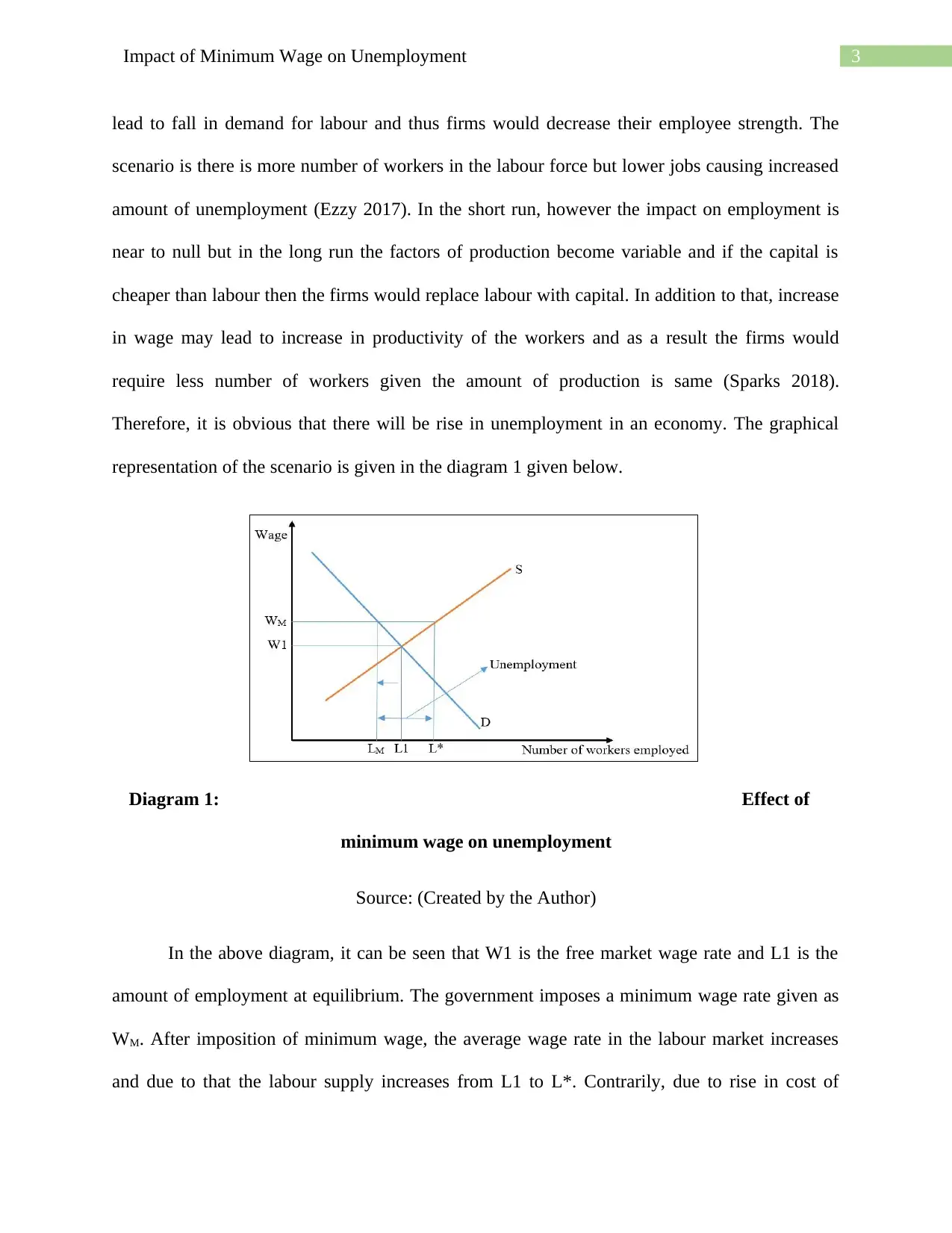
3Impact of Minimum Wage on Unemployment
lead to fall in demand for labour and thus firms would decrease their employee strength. The
scenario is there is more number of workers in the labour force but lower jobs causing increased
amount of unemployment (Ezzy 2017). In the short run, however the impact on employment is
near to null but in the long run the factors of production become variable and if the capital is
cheaper than labour then the firms would replace labour with capital. In addition to that, increase
in wage may lead to increase in productivity of the workers and as a result the firms would
require less number of workers given the amount of production is same (Sparks 2018).
Therefore, it is obvious that there will be rise in unemployment in an economy. The graphical
representation of the scenario is given in the diagram 1 given below.
Diagram 1: Effect of
minimum wage on unemployment
Source: (Created by the Author)
In the above diagram, it can be seen that W1 is the free market wage rate and L1 is the
amount of employment at equilibrium. The government imposes a minimum wage rate given as
WM. After imposition of minimum wage, the average wage rate in the labour market increases
and due to that the labour supply increases from L1 to L*. Contrarily, due to rise in cost of
lead to fall in demand for labour and thus firms would decrease their employee strength. The
scenario is there is more number of workers in the labour force but lower jobs causing increased
amount of unemployment (Ezzy 2017). In the short run, however the impact on employment is
near to null but in the long run the factors of production become variable and if the capital is
cheaper than labour then the firms would replace labour with capital. In addition to that, increase
in wage may lead to increase in productivity of the workers and as a result the firms would
require less number of workers given the amount of production is same (Sparks 2018).
Therefore, it is obvious that there will be rise in unemployment in an economy. The graphical
representation of the scenario is given in the diagram 1 given below.
Diagram 1: Effect of
minimum wage on unemployment
Source: (Created by the Author)
In the above diagram, it can be seen that W1 is the free market wage rate and L1 is the
amount of employment at equilibrium. The government imposes a minimum wage rate given as
WM. After imposition of minimum wage, the average wage rate in the labour market increases
and due to that the labour supply increases from L1 to L*. Contrarily, due to rise in cost of
Paraphrase This Document
Need a fresh take? Get an instant paraphrase of this document with our AI Paraphraser
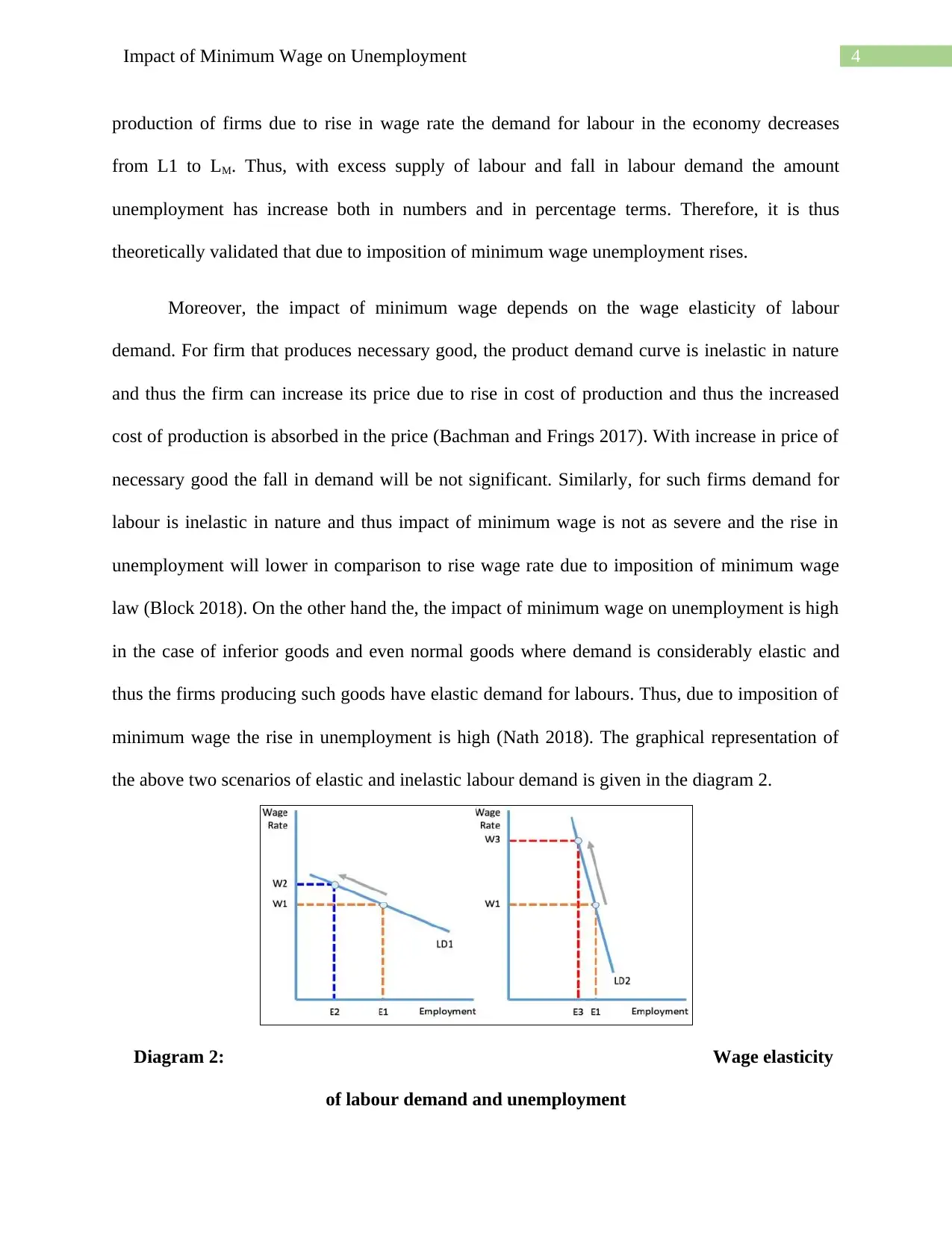
4Impact of Minimum Wage on Unemployment
production of firms due to rise in wage rate the demand for labour in the economy decreases
from L1 to LM. Thus, with excess supply of labour and fall in labour demand the amount
unemployment has increase both in numbers and in percentage terms. Therefore, it is thus
theoretically validated that due to imposition of minimum wage unemployment rises.
Moreover, the impact of minimum wage depends on the wage elasticity of labour
demand. For firm that produces necessary good, the product demand curve is inelastic in nature
and thus the firm can increase its price due to rise in cost of production and thus the increased
cost of production is absorbed in the price (Bachman and Frings 2017). With increase in price of
necessary good the fall in demand will be not significant. Similarly, for such firms demand for
labour is inelastic in nature and thus impact of minimum wage is not as severe and the rise in
unemployment will lower in comparison to rise wage rate due to imposition of minimum wage
law (Block 2018). On the other hand the, the impact of minimum wage on unemployment is high
in the case of inferior goods and even normal goods where demand is considerably elastic and
thus the firms producing such goods have elastic demand for labours. Thus, due to imposition of
minimum wage the rise in unemployment is high (Nath 2018). The graphical representation of
the above two scenarios of elastic and inelastic labour demand is given in the diagram 2.
Diagram 2: Wage elasticity
of labour demand and unemployment
production of firms due to rise in wage rate the demand for labour in the economy decreases
from L1 to LM. Thus, with excess supply of labour and fall in labour demand the amount
unemployment has increase both in numbers and in percentage terms. Therefore, it is thus
theoretically validated that due to imposition of minimum wage unemployment rises.
Moreover, the impact of minimum wage depends on the wage elasticity of labour
demand. For firm that produces necessary good, the product demand curve is inelastic in nature
and thus the firm can increase its price due to rise in cost of production and thus the increased
cost of production is absorbed in the price (Bachman and Frings 2017). With increase in price of
necessary good the fall in demand will be not significant. Similarly, for such firms demand for
labour is inelastic in nature and thus impact of minimum wage is not as severe and the rise in
unemployment will lower in comparison to rise wage rate due to imposition of minimum wage
law (Block 2018). On the other hand the, the impact of minimum wage on unemployment is high
in the case of inferior goods and even normal goods where demand is considerably elastic and
thus the firms producing such goods have elastic demand for labours. Thus, due to imposition of
minimum wage the rise in unemployment is high (Nath 2018). The graphical representation of
the above two scenarios of elastic and inelastic labour demand is given in the diagram 2.
Diagram 2: Wage elasticity
of labour demand and unemployment
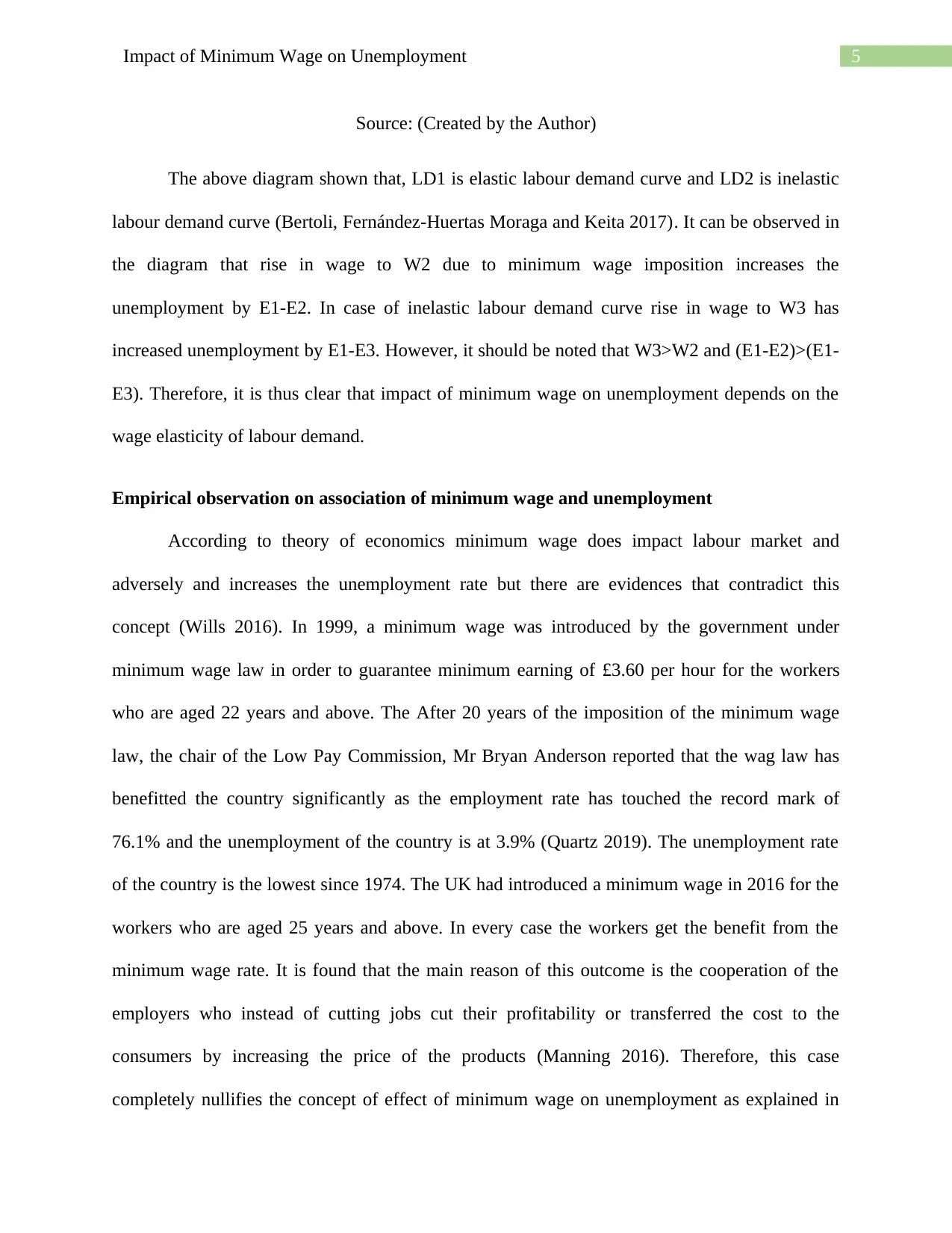
5Impact of Minimum Wage on Unemployment
Source: (Created by the Author)
The above diagram shown that, LD1 is elastic labour demand curve and LD2 is inelastic
labour demand curve (Bertoli, Fernández-Huertas Moraga and Keita 2017). It can be observed in
the diagram that rise in wage to W2 due to minimum wage imposition increases the
unemployment by E1-E2. In case of inelastic labour demand curve rise in wage to W3 has
increased unemployment by E1-E3. However, it should be noted that W3>W2 and (E1-E2)>(E1-
E3). Therefore, it is thus clear that impact of minimum wage on unemployment depends on the
wage elasticity of labour demand.
Empirical observation on association of minimum wage and unemployment
According to theory of economics minimum wage does impact labour market and
adversely and increases the unemployment rate but there are evidences that contradict this
concept (Wills 2016). In 1999, a minimum wage was introduced by the government under
minimum wage law in order to guarantee minimum earning of £3.60 per hour for the workers
who are aged 22 years and above. The After 20 years of the imposition of the minimum wage
law, the chair of the Low Pay Commission, Mr Bryan Anderson reported that the wag law has
benefitted the country significantly as the employment rate has touched the record mark of
76.1% and the unemployment of the country is at 3.9% (Quartz 2019). The unemployment rate
of the country is the lowest since 1974. The UK had introduced a minimum wage in 2016 for the
workers who are aged 25 years and above. In every case the workers get the benefit from the
minimum wage rate. It is found that the main reason of this outcome is the cooperation of the
employers who instead of cutting jobs cut their profitability or transferred the cost to the
consumers by increasing the price of the products (Manning 2016). Therefore, this case
completely nullifies the concept of effect of minimum wage on unemployment as explained in
Source: (Created by the Author)
The above diagram shown that, LD1 is elastic labour demand curve and LD2 is inelastic
labour demand curve (Bertoli, Fernández-Huertas Moraga and Keita 2017). It can be observed in
the diagram that rise in wage to W2 due to minimum wage imposition increases the
unemployment by E1-E2. In case of inelastic labour demand curve rise in wage to W3 has
increased unemployment by E1-E3. However, it should be noted that W3>W2 and (E1-E2)>(E1-
E3). Therefore, it is thus clear that impact of minimum wage on unemployment depends on the
wage elasticity of labour demand.
Empirical observation on association of minimum wage and unemployment
According to theory of economics minimum wage does impact labour market and
adversely and increases the unemployment rate but there are evidences that contradict this
concept (Wills 2016). In 1999, a minimum wage was introduced by the government under
minimum wage law in order to guarantee minimum earning of £3.60 per hour for the workers
who are aged 22 years and above. The After 20 years of the imposition of the minimum wage
law, the chair of the Low Pay Commission, Mr Bryan Anderson reported that the wag law has
benefitted the country significantly as the employment rate has touched the record mark of
76.1% and the unemployment of the country is at 3.9% (Quartz 2019). The unemployment rate
of the country is the lowest since 1974. The UK had introduced a minimum wage in 2016 for the
workers who are aged 25 years and above. In every case the workers get the benefit from the
minimum wage rate. It is found that the main reason of this outcome is the cooperation of the
employers who instead of cutting jobs cut their profitability or transferred the cost to the
consumers by increasing the price of the products (Manning 2016). Therefore, this case
completely nullifies the concept of effect of minimum wage on unemployment as explained in
⊘ This is a preview!⊘
Do you want full access?
Subscribe today to unlock all pages.

Trusted by 1+ million students worldwide
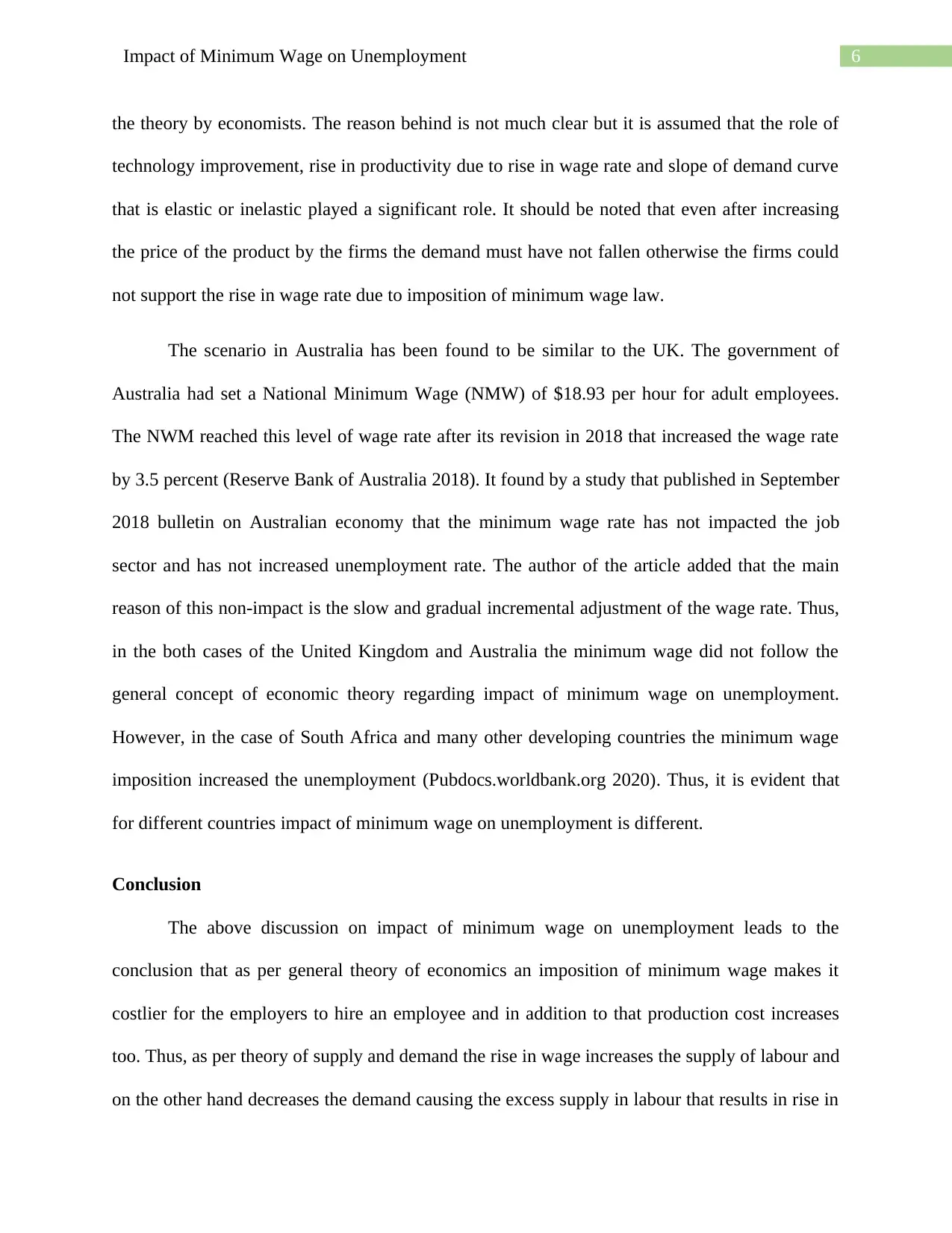
6Impact of Minimum Wage on Unemployment
the theory by economists. The reason behind is not much clear but it is assumed that the role of
technology improvement, rise in productivity due to rise in wage rate and slope of demand curve
that is elastic or inelastic played a significant role. It should be noted that even after increasing
the price of the product by the firms the demand must have not fallen otherwise the firms could
not support the rise in wage rate due to imposition of minimum wage law.
The scenario in Australia has been found to be similar to the UK. The government of
Australia had set a National Minimum Wage (NMW) of $18.93 per hour for adult employees.
The NWM reached this level of wage rate after its revision in 2018 that increased the wage rate
by 3.5 percent (Reserve Bank of Australia 2018). It found by a study that published in September
2018 bulletin on Australian economy that the minimum wage rate has not impacted the job
sector and has not increased unemployment rate. The author of the article added that the main
reason of this non-impact is the slow and gradual incremental adjustment of the wage rate. Thus,
in the both cases of the United Kingdom and Australia the minimum wage did not follow the
general concept of economic theory regarding impact of minimum wage on unemployment.
However, in the case of South Africa and many other developing countries the minimum wage
imposition increased the unemployment (Pubdocs.worldbank.org 2020). Thus, it is evident that
for different countries impact of minimum wage on unemployment is different.
Conclusion
The above discussion on impact of minimum wage on unemployment leads to the
conclusion that as per general theory of economics an imposition of minimum wage makes it
costlier for the employers to hire an employee and in addition to that production cost increases
too. Thus, as per theory of supply and demand the rise in wage increases the supply of labour and
on the other hand decreases the demand causing the excess supply in labour that results in rise in
the theory by economists. The reason behind is not much clear but it is assumed that the role of
technology improvement, rise in productivity due to rise in wage rate and slope of demand curve
that is elastic or inelastic played a significant role. It should be noted that even after increasing
the price of the product by the firms the demand must have not fallen otherwise the firms could
not support the rise in wage rate due to imposition of minimum wage law.
The scenario in Australia has been found to be similar to the UK. The government of
Australia had set a National Minimum Wage (NMW) of $18.93 per hour for adult employees.
The NWM reached this level of wage rate after its revision in 2018 that increased the wage rate
by 3.5 percent (Reserve Bank of Australia 2018). It found by a study that published in September
2018 bulletin on Australian economy that the minimum wage rate has not impacted the job
sector and has not increased unemployment rate. The author of the article added that the main
reason of this non-impact is the slow and gradual incremental adjustment of the wage rate. Thus,
in the both cases of the United Kingdom and Australia the minimum wage did not follow the
general concept of economic theory regarding impact of minimum wage on unemployment.
However, in the case of South Africa and many other developing countries the minimum wage
imposition increased the unemployment (Pubdocs.worldbank.org 2020). Thus, it is evident that
for different countries impact of minimum wage on unemployment is different.
Conclusion
The above discussion on impact of minimum wage on unemployment leads to the
conclusion that as per general theory of economics an imposition of minimum wage makes it
costlier for the employers to hire an employee and in addition to that production cost increases
too. Thus, as per theory of supply and demand the rise in wage increases the supply of labour and
on the other hand decreases the demand causing the excess supply in labour that results in rise in
Paraphrase This Document
Need a fresh take? Get an instant paraphrase of this document with our AI Paraphraser
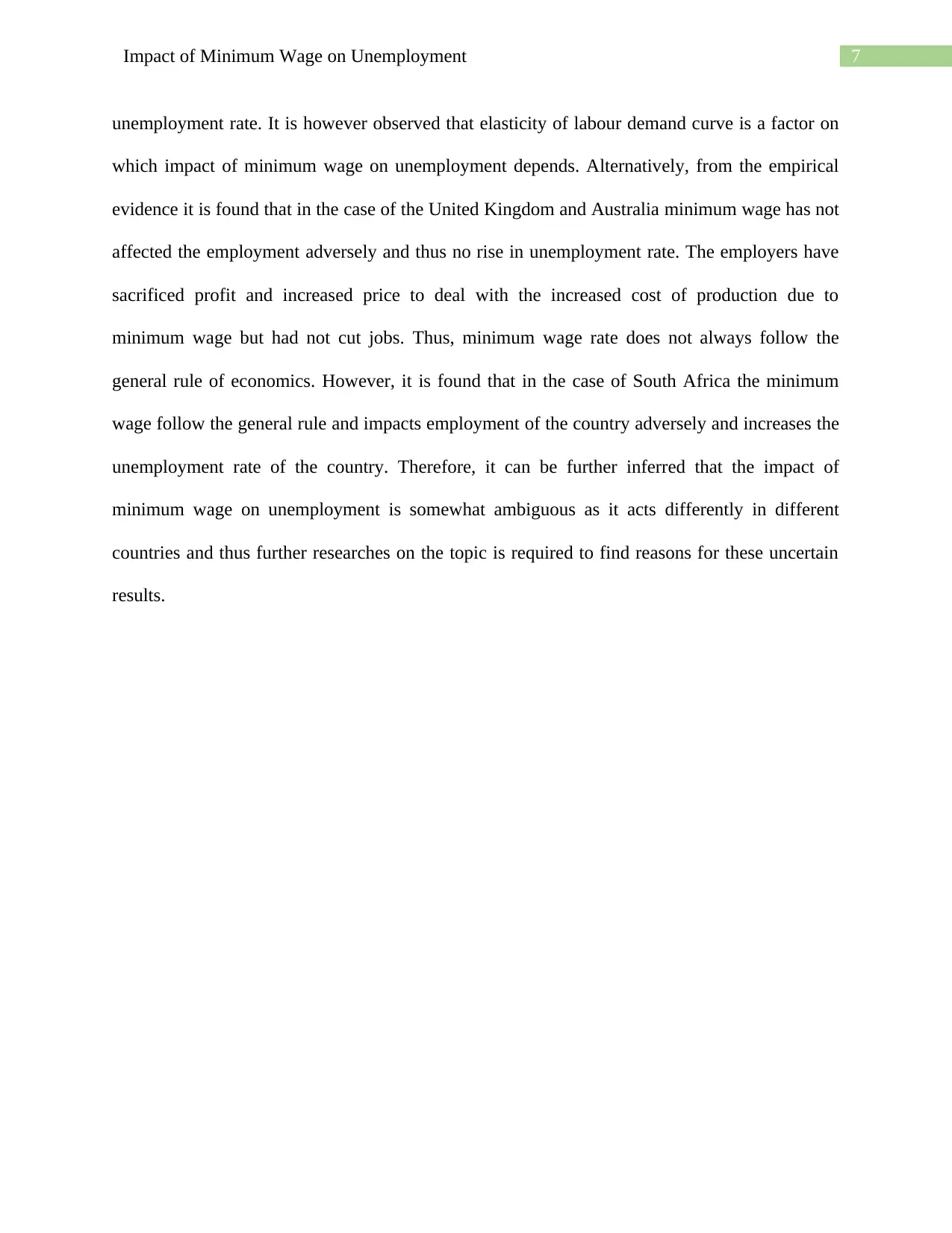
7Impact of Minimum Wage on Unemployment
unemployment rate. It is however observed that elasticity of labour demand curve is a factor on
which impact of minimum wage on unemployment depends. Alternatively, from the empirical
evidence it is found that in the case of the United Kingdom and Australia minimum wage has not
affected the employment adversely and thus no rise in unemployment rate. The employers have
sacrificed profit and increased price to deal with the increased cost of production due to
minimum wage but had not cut jobs. Thus, minimum wage rate does not always follow the
general rule of economics. However, it is found that in the case of South Africa the minimum
wage follow the general rule and impacts employment of the country adversely and increases the
unemployment rate of the country. Therefore, it can be further inferred that the impact of
minimum wage on unemployment is somewhat ambiguous as it acts differently in different
countries and thus further researches on the topic is required to find reasons for these uncertain
results.
unemployment rate. It is however observed that elasticity of labour demand curve is a factor on
which impact of minimum wage on unemployment depends. Alternatively, from the empirical
evidence it is found that in the case of the United Kingdom and Australia minimum wage has not
affected the employment adversely and thus no rise in unemployment rate. The employers have
sacrificed profit and increased price to deal with the increased cost of production due to
minimum wage but had not cut jobs. Thus, minimum wage rate does not always follow the
general rule of economics. However, it is found that in the case of South Africa the minimum
wage follow the general rule and impacts employment of the country adversely and increases the
unemployment rate of the country. Therefore, it can be further inferred that the impact of
minimum wage on unemployment is somewhat ambiguous as it acts differently in different
countries and thus further researches on the topic is required to find reasons for these uncertain
results.
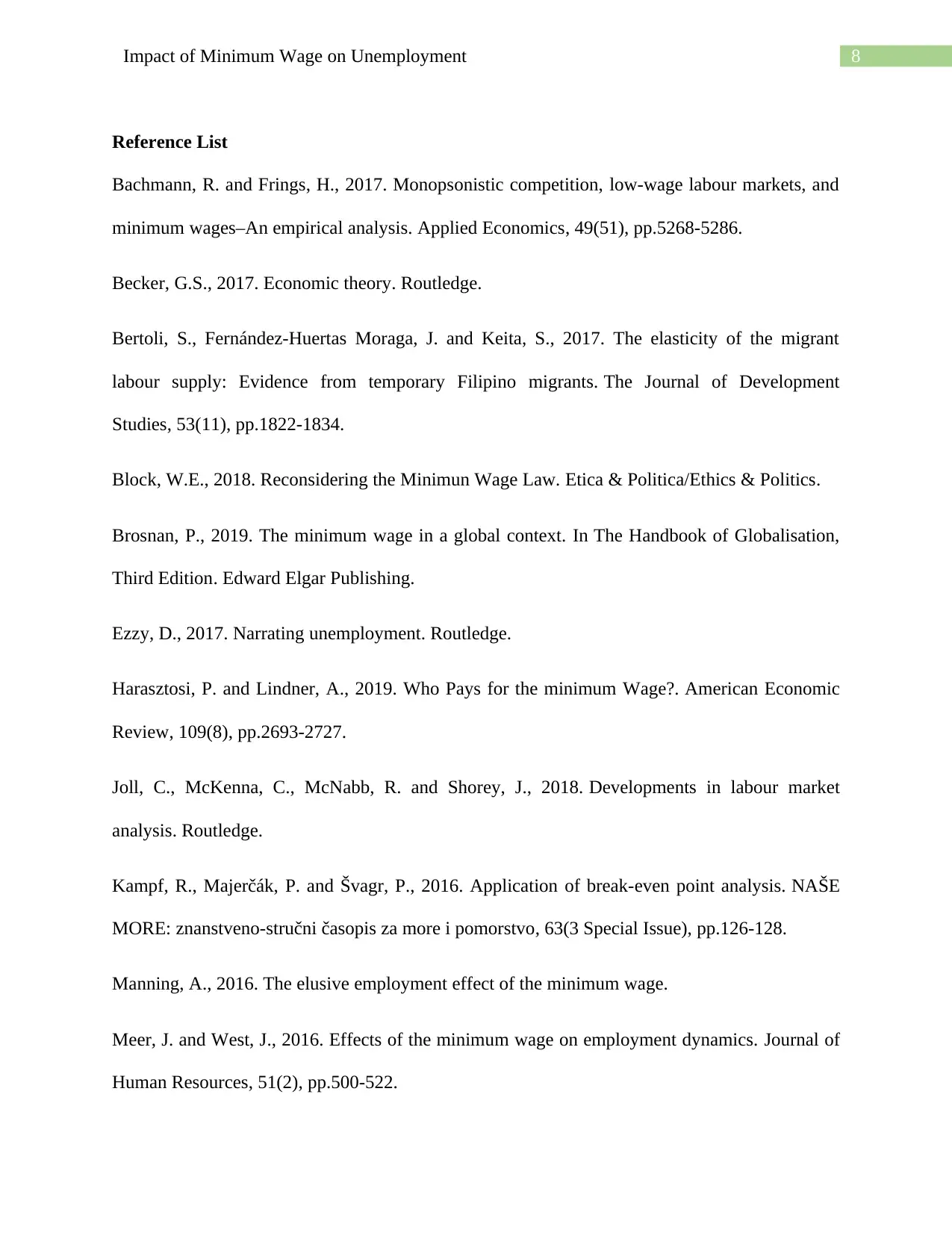
8Impact of Minimum Wage on Unemployment
Reference List
Bachmann, R. and Frings, H., 2017. Monopsonistic competition, low-wage labour markets, and
minimum wages–An empirical analysis. Applied Economics, 49(51), pp.5268-5286.
Becker, G.S., 2017. Economic theory. Routledge.
Bertoli, S., Fernández-Huertas Moraga, J. and Keita, S., 2017. The elasticity of the migrant
labour supply: Evidence from temporary Filipino migrants. The Journal of Development
Studies, 53(11), pp.1822-1834.
Block, W.E., 2018. Reconsidering the Minimun Wage Law. Etica & Politica/Ethics & Politics.
Brosnan, P., 2019. The minimum wage in a global context. In The Handbook of Globalisation,
Third Edition. Edward Elgar Publishing.
Ezzy, D., 2017. Narrating unemployment. Routledge.
Harasztosi, P. and Lindner, A., 2019. Who Pays for the minimum Wage?. American Economic
Review, 109(8), pp.2693-2727.
Joll, C., McKenna, C., McNabb, R. and Shorey, J., 2018. Developments in labour market
analysis. Routledge.
Kampf, R., Majerčák, P. and Švagr, P., 2016. Application of break-even point analysis. NAŠE
MORE: znanstveno-stručni časopis za more i pomorstvo, 63(3 Special Issue), pp.126-128.
Manning, A., 2016. The elusive employment effect of the minimum wage.
Meer, J. and West, J., 2016. Effects of the minimum wage on employment dynamics. Journal of
Human Resources, 51(2), pp.500-522.
Reference List
Bachmann, R. and Frings, H., 2017. Monopsonistic competition, low-wage labour markets, and
minimum wages–An empirical analysis. Applied Economics, 49(51), pp.5268-5286.
Becker, G.S., 2017. Economic theory. Routledge.
Bertoli, S., Fernández-Huertas Moraga, J. and Keita, S., 2017. The elasticity of the migrant
labour supply: Evidence from temporary Filipino migrants. The Journal of Development
Studies, 53(11), pp.1822-1834.
Block, W.E., 2018. Reconsidering the Minimun Wage Law. Etica & Politica/Ethics & Politics.
Brosnan, P., 2019. The minimum wage in a global context. In The Handbook of Globalisation,
Third Edition. Edward Elgar Publishing.
Ezzy, D., 2017. Narrating unemployment. Routledge.
Harasztosi, P. and Lindner, A., 2019. Who Pays for the minimum Wage?. American Economic
Review, 109(8), pp.2693-2727.
Joll, C., McKenna, C., McNabb, R. and Shorey, J., 2018. Developments in labour market
analysis. Routledge.
Kampf, R., Majerčák, P. and Švagr, P., 2016. Application of break-even point analysis. NAŠE
MORE: znanstveno-stručni časopis za more i pomorstvo, 63(3 Special Issue), pp.126-128.
Manning, A., 2016. The elusive employment effect of the minimum wage.
Meer, J. and West, J., 2016. Effects of the minimum wage on employment dynamics. Journal of
Human Resources, 51(2), pp.500-522.
⊘ This is a preview!⊘
Do you want full access?
Subscribe today to unlock all pages.

Trusted by 1+ million students worldwide
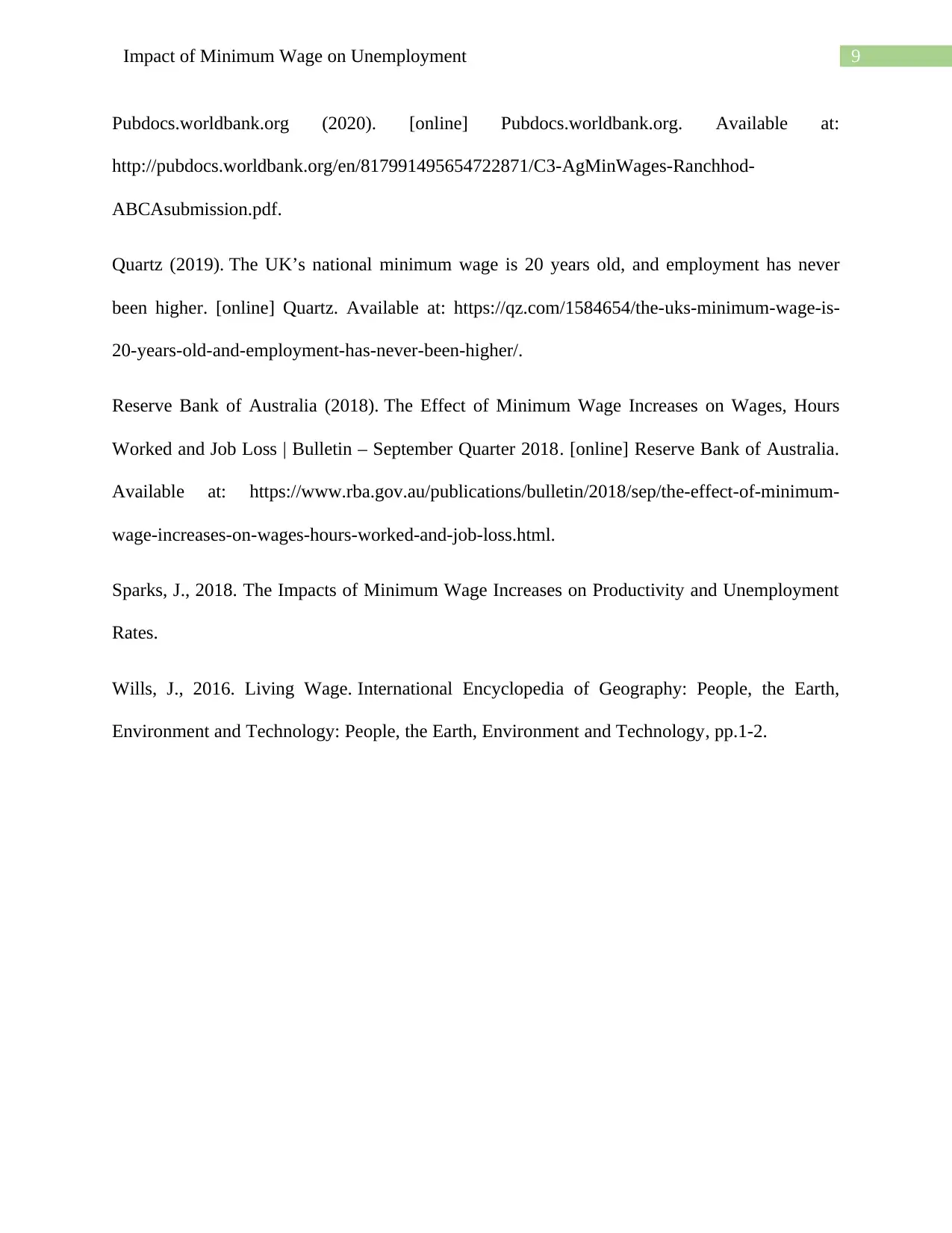
9Impact of Minimum Wage on Unemployment
Pubdocs.worldbank.org (2020). [online] Pubdocs.worldbank.org. Available at:
http://pubdocs.worldbank.org/en/817991495654722871/C3-AgMinWages-Ranchhod-
ABCAsubmission.pdf.
Quartz (2019). The UK’s national minimum wage is 20 years old, and employment has never
been higher. [online] Quartz. Available at: https://qz.com/1584654/the-uks-minimum-wage-is-
20-years-old-and-employment-has-never-been-higher/.
Reserve Bank of Australia (2018). The Effect of Minimum Wage Increases on Wages, Hours
Worked and Job Loss | Bulletin – September Quarter 2018. [online] Reserve Bank of Australia.
Available at: https://www.rba.gov.au/publications/bulletin/2018/sep/the-effect-of-minimum-
wage-increases-on-wages-hours-worked-and-job-loss.html.
Sparks, J., 2018. The Impacts of Minimum Wage Increases on Productivity and Unemployment
Rates.
Wills, J., 2016. Living Wage. International Encyclopedia of Geography: People, the Earth,
Environment and Technology: People, the Earth, Environment and Technology, pp.1-2.
Pubdocs.worldbank.org (2020). [online] Pubdocs.worldbank.org. Available at:
http://pubdocs.worldbank.org/en/817991495654722871/C3-AgMinWages-Ranchhod-
ABCAsubmission.pdf.
Quartz (2019). The UK’s national minimum wage is 20 years old, and employment has never
been higher. [online] Quartz. Available at: https://qz.com/1584654/the-uks-minimum-wage-is-
20-years-old-and-employment-has-never-been-higher/.
Reserve Bank of Australia (2018). The Effect of Minimum Wage Increases on Wages, Hours
Worked and Job Loss | Bulletin – September Quarter 2018. [online] Reserve Bank of Australia.
Available at: https://www.rba.gov.au/publications/bulletin/2018/sep/the-effect-of-minimum-
wage-increases-on-wages-hours-worked-and-job-loss.html.
Sparks, J., 2018. The Impacts of Minimum Wage Increases on Productivity and Unemployment
Rates.
Wills, J., 2016. Living Wage. International Encyclopedia of Geography: People, the Earth,
Environment and Technology: People, the Earth, Environment and Technology, pp.1-2.
1 out of 10
Related Documents
Your All-in-One AI-Powered Toolkit for Academic Success.
+13062052269
info@desklib.com
Available 24*7 on WhatsApp / Email
![[object Object]](/_next/static/media/star-bottom.7253800d.svg)
Unlock your academic potential
Copyright © 2020–2025 A2Z Services. All Rights Reserved. Developed and managed by ZUCOL.





